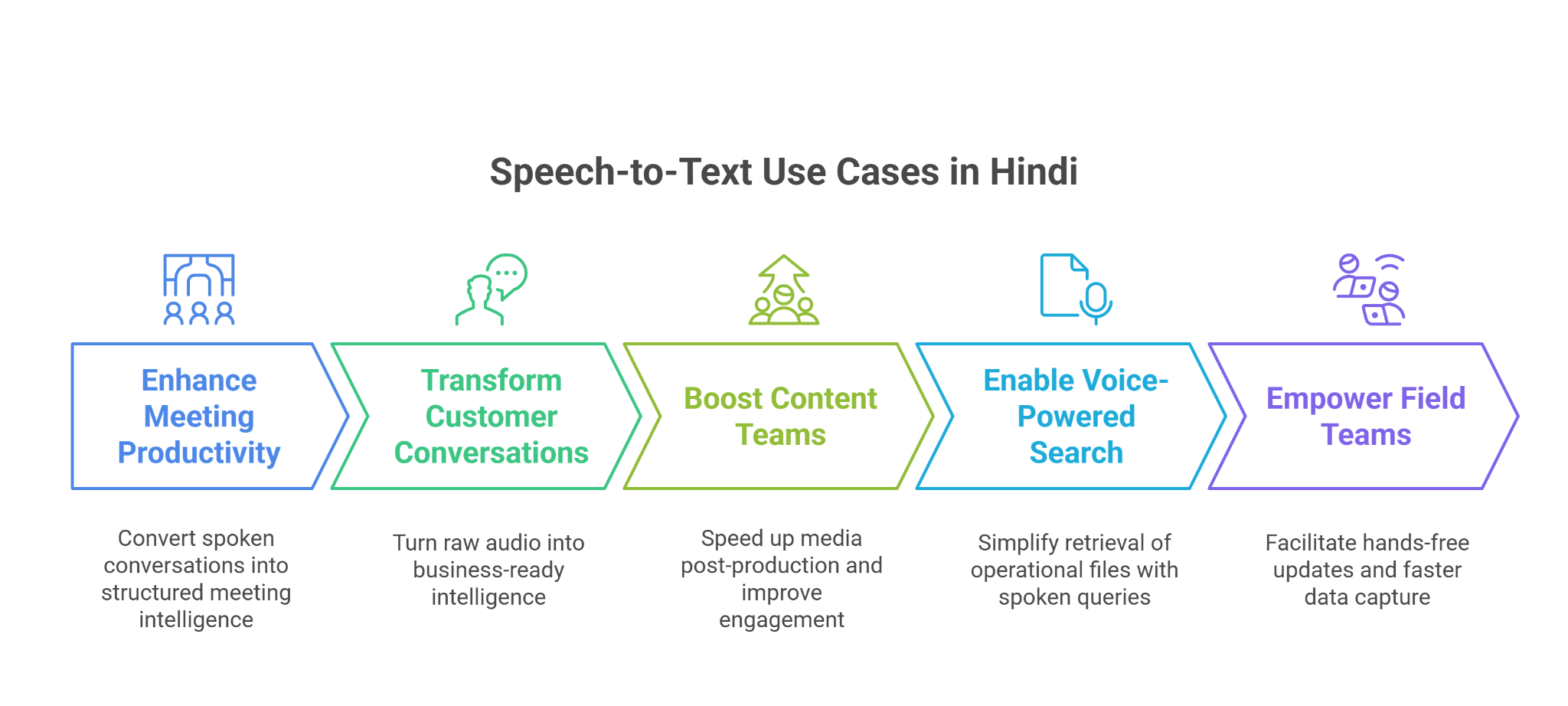With over 528 million native speakers, Hindi remains a powerful driver of communication across India’s diverse business marketplace. From customer service to internal operations, the demand for Hindi-first digital experiences is growing rapidly, especially as businesses look to connect with multilingual users more efficiently.
In parallel, the voice and speech recognition market in India, currently valued at USD 322 million, is projected to grow over threefold by 2030, fuelled by automation and the growing reliance on voice-led data systems. Among these solutions, speech-to-text in Hindi is becoming a core enabler, helping businesses transcribe spoken interactions into structured, actionable content across touchpoints. Whether in banking, media, or retail, organisations are simplifying workflows, reducing manual load, and improving reach by adopting Hindi transcription tools.
The following are the best use cases of speech-to-text in Hindi for businesses operating across industries:

Enhancing Meeting Productivity with Instant Hindi Transcriptions
Business meetings in India frequently happen in Hindi, whether in manufacturing sites, regional sales hubs, or boardroom discussions. But capturing and recalling the key points from these discussions can be inconsistent when notes are manually recorded or later forgotten.
Here is how Hindi speech-to-text helps teams convert voice into structured meeting intelligence:
- Capture spoken conversations as detailed transcripts: Instead of scribbling down notes or depending on memory, businesses can deploy speech-to-text tools that record and transcribe Hindi discussions live. These transcripts serve as a reliable reference for discussions, helping teams revisit decisions, track questions raised, and follow up on assigned tasks.
- Organise meetings by speaker, timestamp, and topic: Modern STT systems can tag speakers and group content into thematic clusters. It helps businesses review and share the right segment of a conversation without listening to entire recordings. This speeds up post-meeting reviews and makes documentation standardised.
- Enable cross-team visibility and follow-through: Transcriptions can be instantly shared with leadership, field teams, or collaborators who were not present. This keeps everyone aligned and reduces redundant clarifications.
Industries Benefiting Most:
- Enterprise Consulting Firms
- Regional Manufacturing Units
- BFSI Internal Teams
- Educational Institutions
Example
A consumer electronics company’s field operations team holds weekly planning discussions in Hindi across zones. With speech-to-text integrated into their conferencing tool, every key conversation is automatically transcribed. Instead of chasing notes, managers share the transcript with internal departments to ensure instant clarity on pricing updates, demand feedback, and stock movement, without anything being lost in translation or memory.
Turning Hindi Customer Conversations into Actionable Business Intelligence
In support centres, field sales, and IVR systems, customer conversations often happen in Hindi. While these voice interactions hold valuable insight, most businesses are unable to extract value from them due to the lack of real-time transcription, analytics, or routing mechanisms tailored to Hindi.
Here’s how speech-to-text in Hindi transforms raw audio into business-ready intelligence:
- Auto-transcribe and index voice calls across touchpoints: Speech-to-text Hindi solutions enable transcription of every Hindi call or audio note into searchable text. This helps teams review customer issues faster, store information systematically, and even integrate voice data into CRM systems for better history tracking.
- Use keyword triggers to automate escalation workflows: Common complaint phrases or intent markers like “refund nahi mila,” “account block ho gaya,” or “wrong item” can trigger ticket generation, escalation, or automated replies, without waiting for manual input from support agents.
- Build analytics dashboards to measure recurring pain points: Business leaders can visualise trends by region, query type, or sentiment across thousands of conversations. This turns support centres into insight hubs that feed product improvements, campaign adjustments, and service redesigns.
Industries Benefiting Most:
- Telecom & Broadband Service Providers
- Fintech and Digital Lending Platforms
- Consumer Electronics & Appliances
- Travel, Mobility, and Ride-Hailing Platforms
Example
A regional insurance provider handles queries from customers in Hindi across multiple service lines. By enabling real-time transcription of calls, they start identifying recurring pain points around claim processing and documentation. These insights are shared with the service design team to simplify workflows, allowing support agents to address root issues faster and more consistently.
Boosting Content Teams with Script and Subtitle Automation
Video, podcast, and voice-based marketing in Hindi is on the rise across sectors, but repurposing voice content into written formats still eats up significant time for content teams. Manual subtitling, transcription, and script extraction delay publishing schedules and increase production costs.
Here is how speech-to-text in Hindi gives content teams the agility they need:
- Speed up the entire media post-production cycle: From pre-recorded interviews to internal training videos, Hindi STT tools generate instant transcripts. It can be converted into subtitles, blog content, or internal documentation, saving hours of manual labour.
- Improve viewer engagement and reach with subtitles: Adding accurate Hindi subtitles improves accessibility for audiences watching with sound off or in noisy environments. It also enhances SEO by making content indexable on platforms like YouTube and search engines.
- Maximise content ROI through multi-format use: By converting one Hindi voice asset into a video, article, podcast, and learning deck, businesses can stretch their creative investments further. This results in serving multiple audience segments without duplicating effort.
Industries Benefiting Most:
- EdTech & Online Learning Platforms
- Media & Publishing Houses
- Corporate Training & HR Tech
- Digital Marketing Agencies
Example
A fintech startup makes educational content in Hindi to guide first-time users on app features. With speech-to-text, they generate subtitles directly from spoken content during recording. These transcripts are also turned into quick-read blog summaries and onboarding checklists. The marketing team repurposes every voice asset into multiple formats without chasing language specialists to convert the material.
Voice-Powered Search and Document Access for Operation Teams
Teams working in support, warehousing, logistics, and admin operations often need to access files and SOPs quickly, but navigating enterprise tools with traditional search inputs can be slow, especially in non-English environments. Manual lookup also causes inefficiencies during time-sensitive workflows.
Here is how Hindi speech-to-text enables smarter, voice-driven search and document access:
- Simplify retrieval of operational files with spoken queries: Teams can ask questions like “dispatch report for today” or “return policy” in Hindi and get instant access to relevant records without scrolling through dashboards.
- Accelerate support response by eliminating search friction: Support executives and backend teams handling Hindi callers can locate order data or resolution templates faster through voice-enabled search.
- Enable accessibility for regional teams with native language voice control: By integrating Hindi voice input, enterprises empower non-English speaking staff across plants and field offices to interact with systems without typing or translation processes.
Industries Benefiting Most:
- Logistics & Supply Chain
- Telecom & Broadband Operations
- Manufacturing Plants
- Insurance and BFSI Back Offices
Example
A telecom company’s backend team supports multilingual customer escalations. Hindi STT search helps them instantly pull up service case files based on voice prompts, shortening call resolution time during high-volume hours.
Empowering Field and Frontline Teams with Mobile Voice Notes
Field agents, logistics staff, and frontline service workers often operate in conditions where typing reports on the go is inefficient or even unsafe. As a result, critical observations are either delayed or omitted, which affects downstream visibility and analytics.
Below is how speech-to-text in Hindi makes mobile reporting faster and more complete:
- Enable hands-free updates using Hindi voice dictation: Whether it’s a delivery confirmation or equipment issue, field agents can speak into mobile apps, and the STT tool captures their input with proper formatting.
- Reduce field reporting gaps with faster data capture: Voice-based reporting in Hindi helps eliminate skipped forms or incomplete entries. The system fills structured fields based on voice data, ensuring reporting consistency.
- Support rural and regional teams with local language input: Hindi STT lets businesses deploy digital field apps without worrying about language onboarding. Teams communicate in the language they’re fluent in, speeding up tech adoption.
Industries Benefiting Most:
- Healthcare & Community Outreach
- Agriculture & AgriTech
- BFSI Field Sales
- Logistics & Hyperlocal Delivery
- Energy & Utilities
Example
A rural microfinance field agent conducts customer visits in Hindi-speaking districts. After each visit, they log loan status and field notes using voice input. The transcribed Hindi text syncs with the central MIS system, resulting in no keyboard or extra paperwork.
Reverie’s Hindi Speech to Text API Built for India’s Business Needs
Businesses across India are increasingly leaning on voice technologies to drive speed, automation, and deeper engagement, especially in Hindi, a language spoken by more than half the country. Reverie’s Speech-to-Text API is designed with this exact need in mind, offering accuracy, language fluency, and integration ease for real-world business applications.
Below are the key capabilities of Reverie’s STT solution that address enterprise needs in Hindi-speaking contexts:
- Built for Indian Languages from the Ground Up
- Supports Hindi and 10+ Indian languages with dialect-aware recognition
- Developed using local phonetic, syntactic, and contextual models
- Handles voice from noisy environments, field inputs, and natural accents
- Seamlessly Integrates into Your Workflow
- Available via secure APIs with easy onboarding through the RevUp platform
- Allows integration into CRMs, support tools, logistics platforms, and mobile apps
- Offers documentation and a sandbox for testing in real-time
- Automates Voice Data Capture Across Use Cases
- Converts spoken Hindi into structured digital text in seconds
- Works for call recordings, meetings, voice notes, and verbal form entries
- Enables real-time automation like alerts, tagging, and content repurposing
- Insight-Ready and Scalable for Enterprise Use
- Comes with usage analytics, custom dashboards, and usage metrics
- Enterprise-ready with SLA-backed performance and localisation support
- Trusted by developers and product teams building for Hindi-first audiences
Final Thoughts
As voice becomes a more natural input method in business, Hindi speech-to-text is quietly transforming how Indian companies interact, document, and deliver services. Teams working in sales, operations, content, and customer service are turning to voice as a faster way to capture, process, and act on information. But to do this right, the underlying technology must understand Indian speech patterns, deliver reliable results, and fit effortlessly into daily workflows.
Tools like Reverie’s Hindi STT API bring linguistic precision, automation potential, and enterprise-grade support together for real impact. If you’re building for Hindi-speaking users or managing operations where voice meets volume, now is the right time to explore STT.
Book a demo now and see how Hindi voice automation can streamline the way your business communicates.
Faqs
How can Hindi speech-to-text help improve internal communication across distributed teams?
Speech-to-text in Hindi converts real-time discussions, updates, or briefings into structured transcripts that teams can share and archive instantly. This ensures alignment, especially when regional teams operate in vernacular languages. Businesses can reduce follow-ups and clarify decisions faster across multiple locations.
What makes speech-to-text in Hindi more effective than traditional transcription methods?
Traditional transcription methods require manual effort and are often inconsistent with local accents, context, or terminology. Hindi STT tools trained on native datasets can transcribe faster, handle colloquial speech, and integrate directly into business platforms, cutting turnaround time and human error.
Can field teams benefit from Hindi speech-to-text without needing new hardware?
Yes, most Hindi STT APIs work seamlessly with existing smartphones or tablets. Field teams can record voice notes, status reports, or task logs in Hindi and have them auto-transcribed instantly. Solutions like Reverie’s STT are optimized for mobile-first deployment, especially in bandwidth-sensitive environments.
How secure is speech-to-text technology when used for customer service or operational documentation?
Business-grade STT tools follow enterprise-level data protection protocols. Some providers, including Reverie, offer on-premise or hybrid deployment options for enterprises that prioritise data localisation, especially for sectors like finance, healthcare, or e-governance.
Which business functions gain the most from Hindi speech-to-text automation?
Teams handling customer support, regional content production, logistics, compliance, and field operations see measurable efficiency gains. By turning spoken Hindi into actionable, text-based insights, these functions experience reduced documentation time and improved multilingual accessibility.

